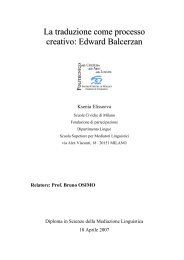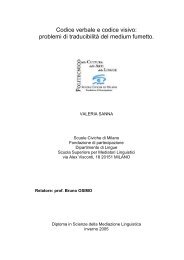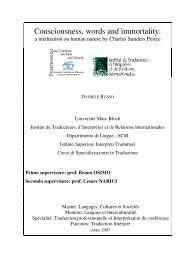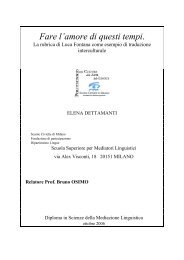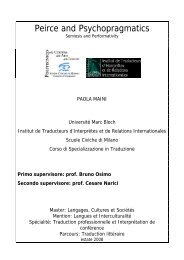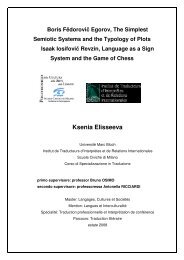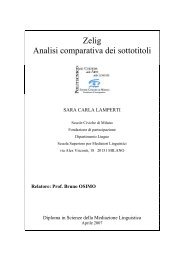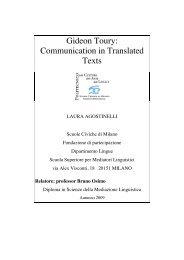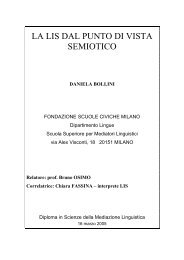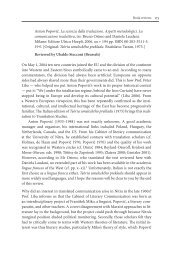A Semiotic Approach to the Theory of Translation: - Bruno Osimo ...
A Semiotic Approach to the Theory of Translation: - Bruno Osimo ...
A Semiotic Approach to the Theory of Translation: - Bruno Osimo ...
Create successful ePaper yourself
Turn your PDF publications into a flip-book with our unique Google optimized e-Paper software.
c) ‘Free’ translation: At its height in eighteenth-century<br />
France. Applied <strong>to</strong> translations <strong>of</strong> <strong>the</strong> classics and o<strong>the</strong>r<br />
belles-lettres. The justification was aes<strong>the</strong>tic, and <strong>the</strong><br />
cultural absolutism in France was its support. Aes<strong>the</strong>tic<br />
classicism preached <strong>the</strong> concept <strong>of</strong> ideal beauty; <strong>the</strong>refore<br />
<strong>the</strong> transla<strong>to</strong>r should try <strong>to</strong> improve on <strong>the</strong> original in<br />
conformity with this ideal, and he had <strong>the</strong> right <strong>to</strong> make<br />
<strong>the</strong> necessary changes in <strong>the</strong> text. But <strong>of</strong> course <strong>the</strong><br />
‘eternal’ ideal was really <strong>the</strong> ideal <strong>of</strong> an Age and <strong>of</strong> a<br />
Culture, and so <strong>the</strong> result was <strong>to</strong> ‘nationalize’ <strong>the</strong> works<br />
translated. This was <strong>the</strong> period <strong>of</strong> Perrot d’Ablancourt’s<br />
“belles infidèles.” The style spread throughout Europe,<br />
even <strong>to</strong> Russia: Vedensky said, “Read <strong>the</strong> text, think how<br />
author would think if he lived under <strong>the</strong> same sky as us,<br />
<strong>the</strong>n change.”<br />
d) ‘Adequate’ translation: nineteenth century till now.<br />
Coincided with <strong>the</strong> new call <strong>to</strong> translate scientific and<br />
technical texts, but was helped along by changes in<br />
aes<strong>the</strong>tics; it was and is still <strong>the</strong> age <strong>of</strong> realism,<br />
concreteness, relativity according <strong>to</strong> place and time. The<br />
transla<strong>to</strong>r should respect <strong>the</strong> author. The aim is <strong>to</strong><br />
preserve content and form.<br />
Of course this periodization is grossly oversimplified and far<br />
from discrete; all <strong>the</strong> types <strong>of</strong> translation mentioned continue <strong>to</strong><br />
be practised down <strong>to</strong> <strong>the</strong> present day, but each period is<br />
characterized by <strong>the</strong> dominance <strong>of</strong> one type.<br />
43



